Fractals using Virtual Manipulatives
1 / 31
Title: Fractals using Virtual Manipulatives
1
Fractals usingVirtual Manipulatives
- Mary Corkery
2
Definition
- Fractal
- Patterns can be found in many objects in nature,
including broccolli. This pattern of repeated
shapes at different scales is part of fractal
geometry.
3
Math Objectives
- Understand
- Iteration
- Self-Similarity
- Fractal
4
Mass Curriculum Frameworks
- G.G.5
- G.M.3
- 10.P.1
5
Language Goals ELPBO Objectives
- Essential vocabulary R.1.14.a
- Fractals, Iteration, Self-Similarities, means
- Use Essential vocab in Speaking W.1.8.b
- Use Essential vocab in Writing W.1.8.b
- Show understanding of Essential vocab by
Listening to teacher and group members S.1.2
6
WWW.SelectMath.com
7
WWW.SELECTMATH.COM
8
Essential questions
- What is a Iteration?
- What is Self-Similarity?
- What is a Fractal?
9
What is a Iteration?
- Process of repeating the same procedure over and
over again
10
What is Self-Similarity?
- When we look at the smaller and smaller details
of a figure, and we find the same geometric
characteristics as the original form. - Self-Similarity is an important characteristic of
Fractals
11
What is a Fractal?
- Fractal is a geometric figure created by
iterations. The patterns structure appears to
go on infinitely.
12
FractalsSierpinski Triangle Iteration 0
13
FractalsSierpinski Iteration -1
14
FractalSierpinksi Iteration 2
15
FractalSierpinski Iteration 3
16
FractalsThe Koch SnowflakeThe Algorithm
- Step One.
- Start with a large equilateral triangle.
- Step Two.
- Make a Star.
- Divide one side of the triangle into three equal
parts and remove the middle section. - Replace it with two lines the same length as the
section you removed. - Do this to all three sides of the triangle.
- Do it again and again.
- Do it infinitely many times and you have a
fractal.
17
Fractals Koch Snowflake Steps 1-4
18
Dynamic Fractals
19
Dynamic Fractals
20
Dynamic Fractals
21
Dynamic Fractals
22
Dynamic Fractals
23
Dynamic Fractals
24
Dynamic Fractals
25
Lesson Objectives
- Content Objectives.
- Understand iteration
- Understand self-similarity
- Understand Fractals
- Language Objectives
- Discuss iteration in small groups
- Discuss self-similarity in small groups
- Describe how to create a Fractal
26
Materials
- Suggested materials for a class of 15 students
- Overhead projector
- White board
- Ruler
- Geometry book( Glencoe)
- Markers
- Graph paper
27
Launch
- Vocabulary
- Think, Pair, Share,Worksheet
- Connect to prior knowledge
- Iteration
- Similar triangles,polygons,
28
Explore
- Practice/Application
- Students will work in their groups and use white
boards to draw successive fractal iterations.
29
Accommodations
- Teacher will circulate among student groups to
answer questions and make sure that the groups
are on the right track
30
Summary /Review
- Students will summarize the goals of the lessons
by orally presenting their solutions on the white
board to the entire class
31
Bibliography
- Geometry Glencoe mathematics
- Massachusetts mathematics curriculum
- English language Proficiency Benchmarks and
Outcomes for ELLs (ELPBO )






























